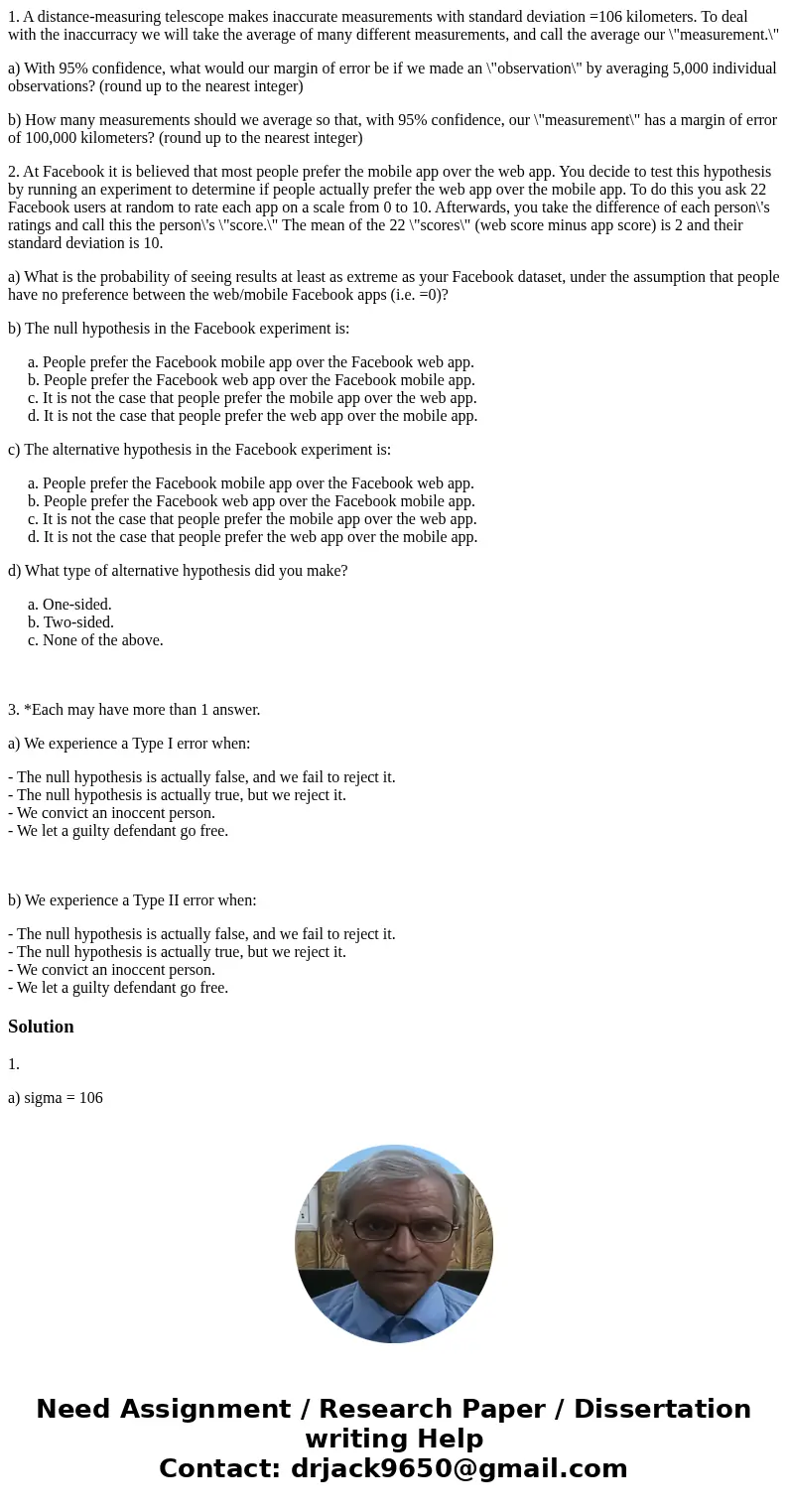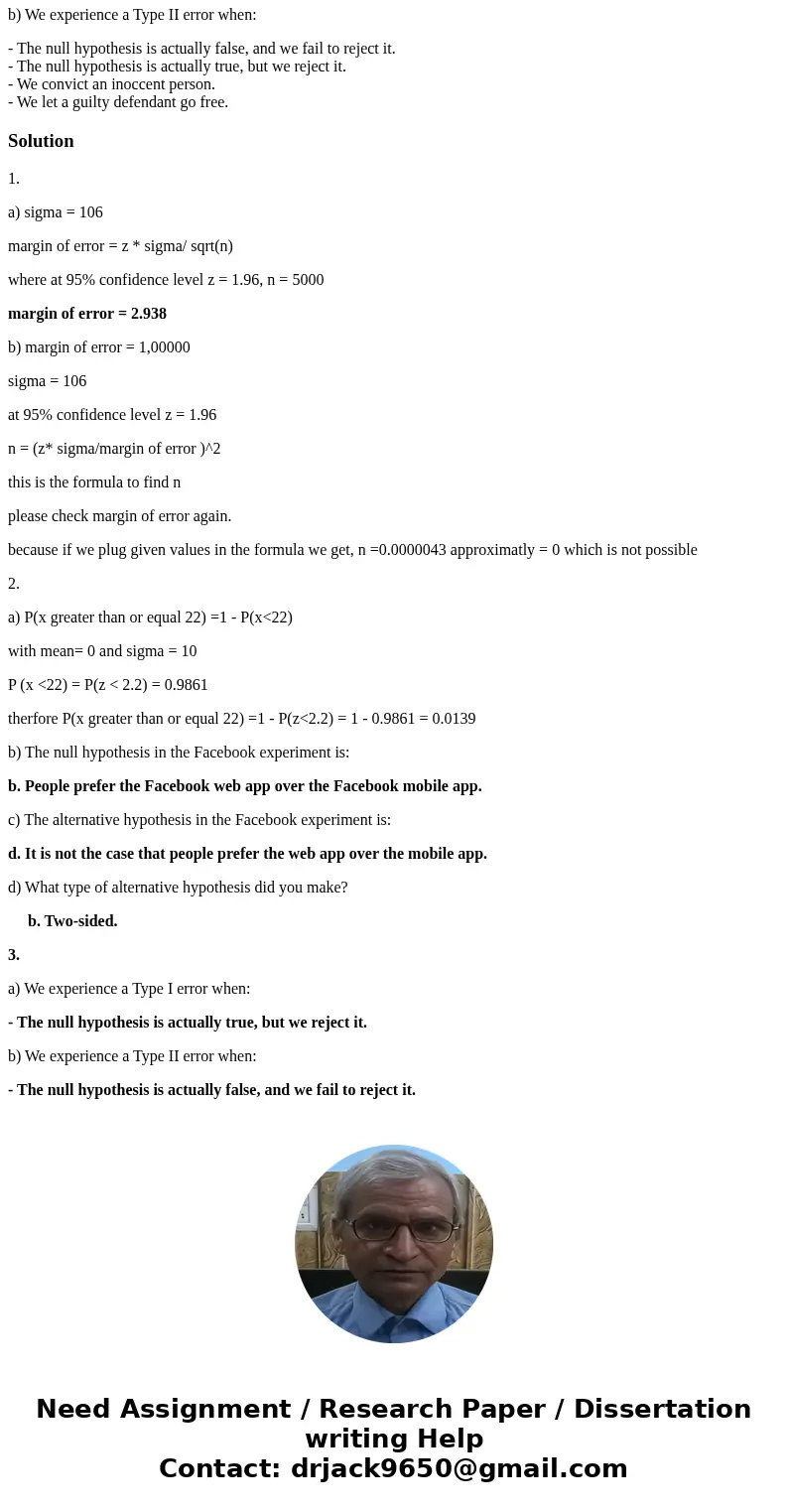1 A distancemeasuring telescope makes inaccurate measurement
1. A distance-measuring telescope makes inaccurate measurements with standard deviation =106 kilometers. To deal with the inaccurracy we will take the average of many different measurements, and call the average our \"measurement.\"
a) With 95% confidence, what would our margin of error be if we made an \"observation\" by averaging 5,000 individual observations? (round up to the nearest integer)
b) How many measurements should we average so that, with 95% confidence, our \"measurement\" has a margin of error of 100,000 kilometers? (round up to the nearest integer)
2. At Facebook it is believed that most people prefer the mobile app over the web app. You decide to test this hypothesis by running an experiment to determine if people actually prefer the web app over the mobile app. To do this you ask 22 Facebook users at random to rate each app on a scale from 0 to 10. Afterwards, you take the difference of each person\'s ratings and call this the person\'s \"score.\" The mean of the 22 \"scores\" (web score minus app score) is 2 and their standard deviation is 10.
a) What is the probability of seeing results at least as extreme as your Facebook dataset, under the assumption that people have no preference between the web/mobile Facebook apps (i.e. =0)?
b) The null hypothesis in the Facebook experiment is:
a. People prefer the Facebook mobile app over the Facebook web app.
b. People prefer the Facebook web app over the Facebook mobile app.
c. It is not the case that people prefer the mobile app over the web app.
d. It is not the case that people prefer the web app over the mobile app.
c) The alternative hypothesis in the Facebook experiment is:
a. People prefer the Facebook mobile app over the Facebook web app.
b. People prefer the Facebook web app over the Facebook mobile app.
c. It is not the case that people prefer the mobile app over the web app.
d. It is not the case that people prefer the web app over the mobile app.
d) What type of alternative hypothesis did you make?
a. One-sided.
b. Two-sided.
c. None of the above.
3. *Each may have more than 1 answer.
a) We experience a Type I error when:
- The null hypothesis is actually false, and we fail to reject it.
- The null hypothesis is actually true, but we reject it.
- We convict an inoccent person.
- We let a guilty defendant go free.
b) We experience a Type II error when:
- The null hypothesis is actually false, and we fail to reject it.
- The null hypothesis is actually true, but we reject it.
- We convict an inoccent person.
- We let a guilty defendant go free.
Solution
1.
a) sigma = 106
margin of error = z * sigma/ sqrt(n)
where at 95% confidence level z = 1.96, n = 5000
margin of error = 2.938
b) margin of error = 1,00000
sigma = 106
at 95% confidence level z = 1.96
n = (z* sigma/margin of error )^2
this is the formula to find n
please check margin of error again.
because if we plug given values in the formula we get, n =0.0000043 approximatly = 0 which is not possible
2.
a) P(x greater than or equal 22) =1 - P(x<22)
with mean= 0 and sigma = 10
P (x <22) = P(z < 2.2) = 0.9861
therfore P(x greater than or equal 22) =1 - P(z<2.2) = 1 - 0.9861 = 0.0139
b) The null hypothesis in the Facebook experiment is:
b. People prefer the Facebook web app over the Facebook mobile app.
c) The alternative hypothesis in the Facebook experiment is:
d. It is not the case that people prefer the web app over the mobile app.
d) What type of alternative hypothesis did you make?
b. Two-sided.
3.
a) We experience a Type I error when:
- The null hypothesis is actually true, but we reject it.
b) We experience a Type II error when:
- The null hypothesis is actually false, and we fail to reject it.


 Homework Sourse
Homework Sourse